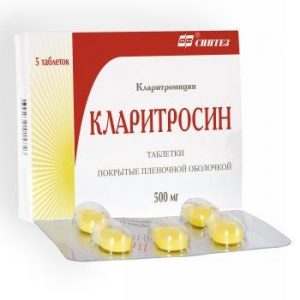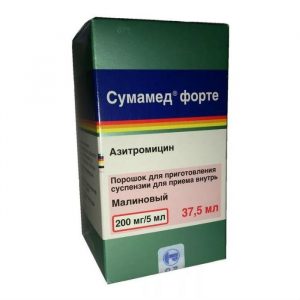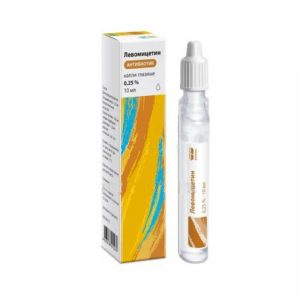Description
Release form
Tablets
Packing
20 pcs.
Pharmacological action
Ampicillin is an antibiotic of the group of semisynthetic penicillins with a wide spectrum of action. It has a bactericidal effect by inhibiting the synthesis of the bacterial cell wall.
Active against gram-positive aerobic bacteria: Staphylococcus spp. (with the exception of penicillinase producing strains), Streptococcus spp. (including Enterococcus spp.), Listeria monocytogenes of gram-negative aerobic bacteria: Neisseria gonorrhoeae, Neisseria meningitidis, Escherichia coli, Shigella spp., Salmonella spp., Bordetella pertussis, some strains of Haemophilus influenzae.
Destroyed by penicillinase. Acid resistant.
Indications
Infectious and inflammatory diseases caused by microorganisms sensitive to ampicillin, including: – respiratory tract infections (including bronchitis, pneumonia, lung abscess)
– infections of the ENT organs (including tonsillitis)
– bile duct infections (including cholecystitis, cholangitis)
– urinary tract infections (including pyelitis, pyelonephritis, cystitis)
– gastrointestinal tract infections (including salmonella carriage)
– gynecological infection
– infections of the skin and soft tissues
– peritonitis
– sepsis, septic endocarditis
– meningitis
– rheumatism
– erysipelas
– scarlet fever
– gonorrhea.
Contraindications
– Hypersensitivity to antibiotics of the
macrolide group – Severe impaired liver and kidney function
– Pregnancy
– Breast-feeding (pause for the duration of treatment)
– Children under 12 years of age p5rorewficenfilmentpfc35351 and other betalactam antibiotics
– severe impaired liver function (for parenteral use).
Use during pregnancy and lactation
It is possible to use the drug during pregnancy if indicated, when the benefit to the mother outweighs the potential risk to the fetus.
Ampicillin is excreted in breast milk with low concentrations. If necessary, the use of the drug during lactation should decide on the termination of breastfeeding.
Special instructions
With caution and against the background of the simultaneous use of desensitizing agents, the drug should be prescribed for bronchial asthma, hay fever and other allergic diseases.
In the process of using Ampicillin, a systematic monitoring of renal function, liver function and peripheral blood picture is necessary.
In liver failure, the drug should be used only under the control of liver function.
Patients with impaired renal function require a dosage adjustment based on QC.
When using the drug in high doses in patients with renal failure, toxic effects on the central nervous system are possible.
When using the drug for the treatment of sepsis, a bacteriolysis reaction (Yarish-Herxheimer reaction) is possible.
If allergic reactions occur during the use of Ampicillin, the drug should be discontinued and desensitizing therapy should be prescribed.
In weakened patients, prolonged use of the drug may develop superinfection caused by ampicillin-resistant microorganisms.
To prevent the development of candidiasis, nystatin or levorin should be prescribed at the same time as ampicillin, as well as B and C. vitamins
Composition
1 tablet contains ampicillin (in the form of 250 mg trihydrate).
Dosage and administration of
When administered orally, the single dose for adults is 250-500 mg, the daily dose is 1-3 g. The maximum daily dose is 4 g.
For children, the drug is prescribed in a daily dose of 50-100 mg / kg, children weighing up to 20 kg – 12.5-25 mg / kg.
The daily dose is divided into 4 doses. The duration of treatment depends on the severity of the infection and the effectiveness of the treatment.
Tablets are taken orally regardless of food intake.
Side effects
Allergic reactions: skin rash, urticaria, Quincke’s edema, pruritus, exfoliative dermatitis, erythema multiforme in rare cases – anaphylactic shock.
From the digestive system: nausea, vomiting, diarrhea, glossitis, stomatitis, pseudomembranous colitis, intestinal dysbiosis, increased activity of hepatic transaminases.
From the hemopoietic system: anemia, leukopenia, thrombocytopenia, agranulocytosis.
Effects due to chemotherapeutic effect: oral candidiasis, vaginal candidiasis.
Drug interaction
Probenecid, when used together with ampicillin, reduces tubular secretion of ampicillin, which increases its concentration in blood plasma and increases the risk of toxic effects.
With the simultaneous use of Ampicillin with allopurinol, the likelihood of skin rash increases.
Concomitant use with ampicillin decreases the effectiveness of estrogen-containing oral contraceptives.
With simultaneous use with ampicillin, the effectiveness of anticoagulants and antibiotic aminoglycosides increases.
Overdose
Appears toxic to the CNS (especially in patients with renal failure).
Treatment: symptomatic.
Storage Conditions
At 15 ° C to 25 ° C.
Terms leave through pharmacies
In retseptu
lekarstvennaja form
tablets
Prescription
For adults as prescribed by a doctor, Children as prescribed by a doctor, Children older than 4 years, Pregnant as prescribed by a doctor
Indications
Indications
Bronchitis, Urinary tract infections, Sinusitis, Pulmonary inflammation, Skin infections, Intestinal infections, Cholecystitis, Angina, Respiratory tract infections, Tonsillitis, Otitis media



